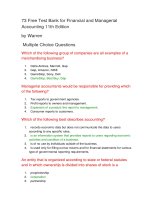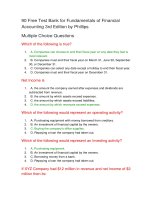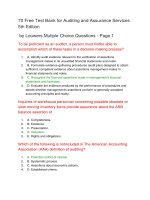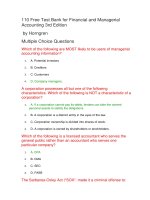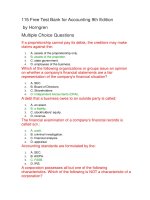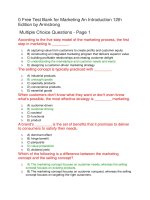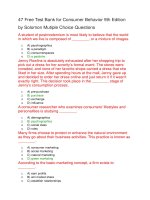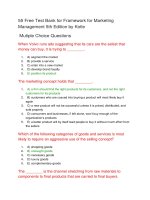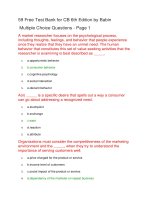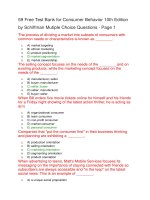115 free test bank for organizations behavior structure processes 14th edition
Bạn đang xem bản rút gọn của tài liệu. Xem và tải ngay bản đầy đủ của tài liệu tại đây (116.68 KB, 23 trang )
50 Free Test Bank for Organizations Behavior
Structure Processes 14th Edition
by Gibson Multiple Choice Questions
25 Free Test True – False Questions
15 Free Test Free Text Questions
50 Free Test Bank for Organizations Behavior
Structure Processes 14th Edition by Gibson Multiple
Choice Questions
This theory has been used to combine goal and systems approaches to
obtain a more appropriate approach to organizational effectiveness.
1.
A. Means and ends
2.
B. Multiple-constituency
3.
C. Multiple-perspective
4.
D. Multiple-measure
Recognition that every organization is part of an industry, a society, and a
global economy is stressed by ______.
1.
A. systems theory
2.
B. global theory
3.
C. constituency theory
4.
D. incremental theory
According to the classical school of management, the four management
functions are ________.
1.
2.
A. establishing a strategic plan, developing an organizational structure, directing
employees, and establishing reward systems
B. individual, group, organizational and societal development
3.
4.
C. analysis, setting of standards, development of reward systems, providing
organizational feedback
D. planning, organizing, leading and controlling
Pat has just set and defined the means to achieve an end. This an example
of ________.
1.
A. strategic planning
2.
B. the planning function
3.
C. establishing reward systems
4.
D. effective leadership
The ________ emphasizes that organizations are chartered to accomplish
goals.
1.
A. systems
2.
B. outcomes
3.
C. goal
4.
D. achievement
The two major categories of inputs are ______ and ______.
1.
A. human and natural resources
2.
B. capital and equipment
3.
C. human and capital
4.
D. capital and natural
Sam has reviewed the quarterly performance reports and compared
results to planned outcomes. What function of management is Pat
fulfilling?
1.
A. Planning
2.
B. Organization
3.
C. Leading
4.
D. Controlling
Managers derive power from ________ sources.
1.
A. organizational
2.
B. individual
3.
C. certified
4.
D. both A and B
The leading function involves which of the following?
1.
A. Close day-to-day contact with individuals and groups
2.
B. Occasional personal interaction with followers
3.
C. The application of precise techniques
4.
D. The growing understanding of how physiology applies to human behavior
Cohesiveness, leadership, structure, status and norms have been
identified as being related to ________.
1.
A. overall effectiveness
2.
B. individual effectiveness
3.
C. group effectiveness
4.
D. All of the above
Environment, technology and structure have been identified as direct
causes of _____________.
1.
A. individual effectiveness
2.
B. group effectiveness
3.
C. organizational effectiveness
4.
D. both individual and group effectiveness
The "four functions" of management _____________.
1.
A. are generally performed by all levels of management
2.
B. each typically require equal attention regardless of management level
3.
C. are interpersonal, decisional, informational and coordination
4.
D. are looked upon as "classic" and no longer relevant
A(n) ________ is a grouping of elements that individually establish
relationships with each other and that interact with each other and that
interact with their environment both as individuals and as a collective.
1.
A. system
2.
B. society
3.
C. transnational
4.
D. structure
Psychology contributes to the study of OB _________.
1.
A. at the individual level of analysis
2.
B. by providing insight into cross-cultural communication
3.
C. by providing insight into intergroup analysis
4.
D. only in a tangential fashion
Synergy _________________.
1.
A. refers to instances where the impact of individual contribution exceeds the
simple summation of work of the individuals separately
2.
B. refers to instances where the individuals work together in teams
3.
C. is developed within the systems function of management
4.
D. falls within Mintzberg's decisional role of management
Pat has identified a list of performance shortfalls. What function of
management is Pat fulfilling?
1.
A. Planning
2.
B. Organization
3.
C. Leading
4.
D. Controlling
Chris interacts daily with the members of the group she supervises. What
function of management is Chris fulfilling?
1.
A. Planning
2.
B. Organization
3.
C. Leading
4.
D. Controlling
__________ interact to determine individual performance.
1.
A. Motivation and ability
2.
B. Structure and leadership
3.
C. Pay and individual needs
4.
D. None of the above
The _________ approach, in concrete terms, means achieving balance
among the various parts of the system by satisfying the interests of the
organization's constituency.
1.
A. systems
2.
B. stakeholder
3.
C. constituency
4.
D. goal
While not strictly an ordered sequence, which management function must
typically occur before the organizing function?
1.
A. Planning
2.
B. Goal setting
3.
C. Controlling
4.
D. Forecasting
Which of the following fields have been identified as contributing to the
knowledge and application of OB?
1.
A. Psychology
2.
B. Social psychology
3.
C. Sociology
4.
D. All of the above
As changes occur in workforce technology, the economy, competition,
social trends and world politics it is inevitable the leaders will turn to
_________.
1.
A. organizational development interventions
2.
B. organizational advancement interventions
3.
C. organizational encroachment interventions
4.
D. political behaviors
Pat is sharing performance information with the organization. Which of
Mintzberg's roles is Pat performing?
1.
A. Information
2.
B. Leading
3.
C. Controlling
4.
D. Executive
Chris is establishing the resource allocations for the organization. Which
of Mintzberg's three roles is Chris performing?
1.
A. Interpersonal
2.
B. Decision
3.
C. Executive
4.
D. Strategic
"Influence" is associated with the _________ function of management.
1.
A. interpersonal
2.
B. leading
3.
C. organizing
4.
D. controlling
Which of the following have been recognized as difficulties with the goal
approach to effectiveness?
1.
2.
3.
4.
A. Goal achievement is difficult to measure in organizations that do not produce a
tangible product.
B. The achievement of one goal may diminish the results of a second goal.
C. The existence of a common set of "official" goals to which all members are
committed is questionable.
D. All of the above.
Approaches to effectiveness include _____________.
1.
A. goal approach
2.
B. systems theory
3.
C. Both A and B
4.
D. None of the above
The pattern of basic assumptions used by individuals and groups to deal
with the organization and its environment is called ____________.
1.
A. structure
2.
B. culture
3.
C. holistics
4.
D. synergistic
The fields of management and organizational behavior are _______.
1.
A. ones of precise language and definitions comparable to those found in physics
2.
B. not exact sciences
3.
C. exact sciences
4.
D. enriched by their history of over 200 years of formal study
The "basic elements" of a system include which of the following?
1.
A. People, materials and private ownership
2.
B. Inputs and outputs
3.
C. Inputs, process and outputs
4.
D. Resource identification, utilization and conversion
In determining effectiveness Pat has considered the organization's impact
on shareholders, employees, customers and the community. What
approach to effectiveness has Pat applied?
1.
A. Classification
2.
B. Stakeholder
3.
C. Universal
4.
D. Interest
In simplest terms, ________ refers to information that reflects the
outcomes or an act of a series of acts by an individual, group, or
organization.
1.
A. evaluative
2.
B. reflective
3.
C. feedback
4.
D. control signals
This term has been defined as the blueprint that indicates how people and
jobs are grouped together in an organization.
1.
A. Configuration
2.
B. Structure
3.
C. Organization
4.
D. None of the above
The systems theory approach to effectiveness _________.
1.
A. emphasizes that the ultimate survival of an organization depends on its ability
to understand employee requirements
2.
B. emphasizes that in meeting the changing demands of the environment, the total
cycle of input-process-output must be the focus of managerial attention
3.
C. both A and B
4.
D. None of the above
In the reality of organizational life there are ______ cause-and-effect
relationships.
1.
A. always clear
2.
B. always ambiguous
3.
C. few unambiguous
4.
D. typically clear
Carol is determining the appropriate structure of her organization. What
function of management is she fulfilling?
1.
A. Planning
2.
B. Organization
3.
C. Leading
4.
D. Controlling
The three levels of focus or analysis of OB are: ____________,
____________, and ____________.
1.
A. individual, group, and organization
2.
B. first level, middle and upper management
3.
C. structural, prostructural and anitstructural
4.
D. cognitive, affective and emotional
In straightforward terms, the organization's ____________ is its
personality, atmosphere, or "feel."
1.
A. atmosphere
2.
B. ambiance
3.
C. culture
4.
D. ethos
The systems theory approach to effectiveness _________.
1.
A. proposes that a firm survives as long as its output is purchased in the market in
quantities and at prices that enable it to replenish its depleted stock of inputs
2.
B. is most appropriate for manufacturing operations
3.
C. considers the complex interaction of the needs and wants
4.
D. all of the above
Pat has created a structure to support a plan. Which management function
has pat just completed?
1.
A. Structuring
2.
B. Extended planning
3.
C. Organizing
4.
D. Controlling
Mintzberg identified ________.
1.
A. three roles of management
2.
B. four functions of management
3.
C. the psychoanalytical aspects of OB
4.
D. the classical perspective of OB
The ______ approach is the oldest and most widely used evaluation
approach.
1.
A. systems theory
2.
B. goal
3.
C. stakeholder
4.
D. objective
Organizational effectives is a(n) _____________.
1.
A. result solely of individual effectiveness
2.
B. increasingly important topic
3.
C. product of both individual and group effectiveness
4.
D. not a primary concern of the study of OB
The three perspectives on effectiveness are: _________.
1.
A. win, lose, draw
2.
B. individual, group and organizational
3.
C. individual, group and financial
4.
D. financial, strategic and social
Within the stakeholder approach, judgments of effectiveness always
involve ___________.
1.
A. quantitative analysis
2.
B. the application of expert opinions
3.
C. value judgments
4.
D. all of the above
Standards of performance are associated with the _______ management
function.
1.
A. interpersonal
2.
B. leading
3.
C. organizing
4.
D. controlling
An organization is ____________.
1.
A. a coordinated unit
2.
B. a unit of at least two people
3.
C. a unit that functions to achieve a common goal or set of goals
4.
D. all of the above
Pat considers the financial viability of the firm as the ultimate measure of
effectiveness. Which of the following best describes Pat's approach to
effectiveness?
1.
A. Systems
2.
B. Consultation
3.
C. Constituency
4.
D. Goal
Which of the following fields was not specifically identified in the text as
contributing to the knowledge and application of OB?
1.
A. Social psychology
2.
B. Anthropology
3.
C. Industrial organizational sociology
4.
D. Political science
Your professors may have stated that it's the management's responsibility
to devise integrating methods and processes. What function of
management were they referring to?
1.
A. Planning
2.
B. Leading
3.
C. Organizing
4.
D. Controlling
25 Free Test Bank for Organizations Behavior
Structure Processes 14th Edition by Gibson True False Questions
Goal achievement isn't readily measurable for organizations that don't
produce tangible products.
1.
True
2.
False
The firm has two major categories of inputs: manufacturing and
customer.
1.
True
2.
False
Group performance is the foundation of organizational performance.
1.
True
2.
False
The effectiveness of any organization is influenced greatly by human
behavior.
1.
True
2.
False
Planning involves establishing where the organization is going but not
how it is going to get there.
1.
True
2.
False
Anthropology has contributed to the study and application of OB.
1.
True
2.
False
"Culture" is the pattern of basic assumptions used by individuals and
groups to deal with the organization and its environment.
1.
True
2.
False
Groups form within organizations exclusively to address formal
organizational needs.
1.
True
2.
False
To be formally defined as an "organization" the entity must consist of at
least two people and be profit oriented.
1.
True
2.
False
Job design looks at contents, methods and relationships of jobs to the
exclusive end of meeting organizational requirements.
1.
True
2.
False
The formal study of organizational behavior is believed to have begun
between 1903 and 1917.
1.
True
2.
False
The controlling function looks only at the organizational level of
effectiveness.
1.
True
2.
False
The systems approach provides the structure to effectively evaluate
organizational impact on "stakeholders."
1.
True
2.
False
The essence of power is control over others.
1.
True
2.
False
Mintzberg is known for identifying the four functions of management.
1.
True
2.
False
Organizational effectiveness is a result of both individual and group
effectiveness.
1.
True
2.
False
The goal approach makes evaluation of success easier in those
organizations that do not produce tangible products.
1.
True
2.
False
"Structure" is the formal pattern of how jobs but not people are grouped.
1.
True
2.
False
The Classical School proposed that management work consists of distinct
but unrelated functions which together constitute the management
process.
1.
True
2.
False
Job design refers to the process by which managers specify the contents,
methods, and relationships of jobs to satisfy both organizational and
individual requirements.
1.
True
2.
False
Systems theorist propose that systems can be categorized in three ways:
conceptual, interpersonal and concrete.
1.
True
2.
False
Leadership and quality concepts have been found to be inseparable.
1.
True
2.
False
Managers derive power from both organizational and individual sources.
1.
True
2.
False
The text provides stress as a cause of both individual and group
effectiveness.
1.
True
2.
False
The "organizational environment" includes the market and technology but
generally excludes governmental activities due to the "commerce clause."
1.
True
2.
False
15 Free Test Bank for Organizations Behavior
Structure Processes 14th Edition by Gibson Free Text
Questions
The goal approach to effectiveness suffers from several difficulties. Detail
and provide examples for these difficulties.
Answer Given
The goal approach, for all its appeal and apparent simplicity, has problems. A few
recognized difficulties include the following: 1) Goal achievement isn't readily
measurable for organizations that don't produce tangible outputs. For example, a
college's goal is to provide a liberal education at a fair price. The question is how
would we know whether the college reaches that goal? What's a liberal education?
What's a fair price? 2) Organizations attempt to achieve more than one goal, but
achieving one goal often precludes or diminishes their ability to achieve other
goals. A firm states that its goal is to maximize profit and to provide absolutely
safe working conditions. These two goals are in conflict because one is achieved
at the expense of the other; 3) The very existence of a common set of "official"
goals to which all members are committed is questionable. Various researchers
have noted the difficulty of obtaining consensus among managers as to their
organization's specific goals.
Describe the types of environmental forces that make it necessary for
organizations to initiate changes.
Answer Given
Answers will vary but may include changes in workforce technology, the economy,
competition, social trends, and world politics.
Three perspectives on organizational effectiveness are presented in the
text. Describe each of these perspectives and how they interrelate.
Answer Given
Answers will vary but should include the following concepts. Managers routinely
assess individual effectiveness through performance evaluation processes to
determine who should receive salary increases, promotions, and other rewards
available in the organization. Individuals seldom work alone, in isolation from
others in the organization. Usually employees work in groups, necessitating yet
another perspective on effectiveness: group effectiveness. In some instances,
group effectiveness is simply the sum of the contributions of all its members. The
third perspective is organizational effectiveness. Organizations consist of
individuals and groups; therefore, organizational effectiveness consists of
individual and group effectiveness. But organizational effectiveness is more than
the sum of individual and group effectiveness. Through synergistic effects,
organizations obtain higher levels of effectiveness than the sum of their parts. In
fact, the rationale for organizations as a means for doing society's work is that
they can do more work than is possible through individual effort. Figure 1.2
reveals the relationships among three perspectives on effectiveness. The
connecting arrows imply that group effectiveness depends on individual
effectiveness, while organizational effectiveness depends on individual and group
effectiveness. The exact relationships among the three perspectives vary
depending on such factors as the type of organization, the work it does, and the
technology used in doing that work. Figure 1.3 recognizes the three perspectives'
synergistic effects. Thus, group effectiveness is larger than the sum of individuals'
effectiveness because of the synergies realized through joint efforts
organizational, group, and individual effectiveness.
Describe the three perspectives on determining effectiveness. What
perspective is best suited for your university? Justify your response.
Answer Given
Student answers should include the following points. Goal theory is based on the
idea that organizations are rational, purposive entities pursuing specific missions,
goals, and objectives. Accordingly, how well they function (i.e., how effective they
are) is reckoned in terms of how successful they are in achieving their purposes.
Systems theory assumes that organizations are social entities existing as parts of
larger environments and that, to survive, they function to satisfy the demands of
those environments. Effectiveness in this perspective emphasizes the relative
importance of different groups' and individuals' interests in an organization. The
stakeholder perspective on organizational effectiveness recognizes that
organizations exist to satisfy the demands of many different individuals and
institutions (constituencies). Each constituency has expectations that the
organization must satisfy through its performance.
The text provides several facets of individual behavior managers must
understand to influence individual performance. What are these areas and
their relevance to individual performance?
Answer Given
Answers will vary but should include the following concepts. Individual
performance is the foundation of organizational performance. Understanding
individual behavior is therefore critical for effective management. Managers
typically must deal with several facets of individual behavior. Individual
Characteristics: Because organizational performance depends on individual
performance, managers must have more than a passing knowledge of the
determinants of individual performance. Psychology and social psychology
contribute relevant knowledge about the relationships among attitudes,
perceptions, personality, values, and individual performance. Managers can't
ignore the necessity for acquiring and acting on knowledge of the individual
characteristics of both their subordinates and themselves. Individual Motivation:
Motivation and ability to work interact to determine performance. Motivation theory
attempts to explain and predict how individuals' behavior is aroused, sustained,
and stopped. Not all managers and behavioral scientists agree on what is the best
theory of motivation. In fact, the complexity of motivation may make an allencompassing theory of how it occurs impossible. But managers must still try to
understand it. They must be concerned with motivation because they must be
concerned with performance. Rewards and Appraisal: One of the most powerful
influences on individual performance is an organization's reward system.
Management can use rewards to increase current employees' performance. It can
also use rewards to attract skilled employees to the organization.
Discuss the origins of the field of organizational behavior and why an
understanding of the field is important to today's manager.
Answer Given
The formal study of organizational behavior began between 1948 and 1952. This
still-emerging field attempts to help managers understand people better so that
productivity improvements, customer satisfaction, and a better competitive
position can be achieved through better management practices. The behavioral
sciences—especially psychology, sociology, political science, and cultural
anthropology—have provided the basic framework and principles for the field of
organizational behavior. Each behavioral science discipline provides a slightly
different focus, analytical framework, and theme for helping managers answer
questions about themselves, nonmanagers, and environmental forces (e.g.,
competition, legal requirements, and social/political changes). The
multidisciplinary definition of organizational behavior illustrates a number of points.
First, OB indicates that behaviors of people operate at individual, group, and
organizational levels. This approach suggests that when studying OB we must
identify clearly the level of analysis—individual, group, and/or organizational—
being used. Second, OB is multidisciplinary; it uses principles, models, theories,
and methods from other disciplines. The study of OB isn't a discipline or a
generally accepted science with an established theoretical foundation. It's a field
that only now is beginning to grow and develop in stature and impact. Third,
there's a distinctly humanistic orientation within organizational behavior. People
and their attitudes, perceptions, learning capacities, feelings, and goals are
important to the organization. Fourth, the field of OB is performance oriented. Why
is performance low or high? How can performance be improved? Can training
enhance on-the-job performance? These are important issues facing managers.
Fifth, the external environment is seen as having significant effect on
organizational behavior. Sixth, because the field of OB relies heavily on
recognized disciplines, the scientific method is important in studying variables and
relationships. As the scientific method has been applied to research on
organizational behavior, a set of principles and guidelines on what constitutes
good research has emerged. Finally, the field has a distinctive applications
orientation; it concerns providing useful answers to questions that arise in the
context of managing operations.
Management typically performs four functions. Identify and define these
functions. Provide an example of each within the context of your school.
Answer Given
Answers will vary and the examples provided will be location specific. In general
answers should include the following. The concept of management developed in
the text is based on the assumption that the necessity for managing arises
whenever work is specialized and undertaken by two or more persons. Under
such circumstances, the specialized work must be coordinated, creating the
necessity for managerial work. The nature of managerial work is then to
coordinate the work of individuals, groups, and organizations by performing four
management functions: planning, organizing, leading, and controlling. Figure 1.4
depicts management's contribution to effectiveness. While this list might be
arbitrary, managers at all levels of the organization generally perform these
functions. The relative importance of one function vis-à-vis another function differs
depending on where the manager is in the organization and what problems and
issues the manager faces. But the ability to discern the relative importance of
planning, organizing, leading, and controlling may distinguish effective managers
from ineffective managers.
Organizational behavior is not as stable or as predictable as physics.
What is this statement saying about the field of OB?
Answer Given
Answers will vary but should reflect the following. There is no set of universal
prescriptions that can predict every behavior, team outcome, or organizational
phenomenon. People are typically unique and unpredictable in some aspects of
their behavior. In physics there are laws, formulas, and mathematical procedures
that apply to a wide range of situations. The speed of a vehicle traveling down a
hill can be calculated, and the answer applies to similar hills, cars, and conditions.
Mintzberg has been credited with the identification of three roles of
management. What are these roles and provide examples of each.
Answer Given
Answers will vary but should include the following. Henry Mintzberg's influential
study identified three primary and overlapping managerial roles: interpersonal role,
decisional role, and informational role. Each role has several related activities that
distinguish it from the others. Interpersonal role activities clearly involve the
manager with other people both inside and outside the organization. Decisional
role activities involve the manager in making decisions about operational matters,
resource allocation, and negotiations with the organization's constituencies. The
informational role involves the manager as a receiver and sender of information to
a variety of individuals and institutions.
Identify why managing workplace behavior in the United States is likely to
be different from managing workplace behavior in another country, such
as Germany.
Answer Given
Answers will vary but should include reference to the contingency approach and
may mention items such as culture, differing expectations and needs.
Compare the goal, systems, and multiple-constituency approaches to
effectiveness.
Answer Given
Answers will vary but may include elements of the following points. Goal theory is
based on the idea that organizations are rational, purposive entities pursuing
specific missions, goals, and objectives. Accordingly, how well they function (i.e.,
how effective they are) is reckoned in terms of how successful they are in
achieving their purposes. Systems theory assumes that organizations are social
entities existing as parts of larger environments and that, to survive, they function
to satisfy the demands of those environments. The stakeholder perspective on
organizational effectiveness recognizes that organizations exist to satisfy the
demands of many different individuals and institutions (constituencies). Each
constituency has expectations that the organization must satisfy through its
performance. One study of the applicability of multiple-constituency theory
suggests that it may in fact integrate both the system and goal approaches to
effectiveness. The study documents that some constituencies favor outcomes
related to means (the process element in systems), while others favor outcomes
related to ends (the outcome element in systems). Thus, it's possible to use the
multiple-constituency theory to combine the goal and systems approaches to
obtain a more appropriate approach to organizational effectiveness. But even if we
can resolve the differences between the goal and systems approaches with
respect to what different constituencies desire from organizational performance,
we still must recognize that these desires can change with and over a period of
time.
Explain the contingency approach to managing individuals' behavior
within an organizational setting.
Answer Given
The basic idea of the contingency approach is that there's not one best way to
manage; a method that's very effective in one situation may not work at all in
others. The contingency approach has grown in popularity because research has
shown that given certain characteristics of a job and certain characteristics of the
people doing the job, some management practices work better than others.
The book presents two behavioral processes that contribute to effective
organizational processes. What are these processes, how are they related
to effective organizational process and provide examples of each?
Answer Given
The text discusses two behavioral processes that contribute to effective
organizational performance: communication and decision making.
Communication: Organizational survival is related to management's ability to
receive, transmit, and act on information. The communication process links the
organization to its environment as well as to its parts. Information flows to and
from the organization and within the organization. Information integrates the
activities within the organization. Decision Making: The quality of decision making
in an organization depends on selecting proper goals and identifying means for
achieving them. With good integration of behavior and structural factors,
management can increase the probability that high-quality decisions are made.
Organizations rely on individual decisions as well as group decisions. Effective
management requires knowledge about both types of decisions.
Describe each of the four functions of management. Which of these
functions do you believe is the most important and why?
Answer Given
Answers will vary however should include an overview of planning, organizing,
leading and controlling. Students may note that different levels of management
typically divide their time between these functions differentially.
Multiple fields have contributed to study and application of OB. Identify
these fields and their contributions.
Answer Given
Answers will vary but should reflect the contents of figure 1.1 and include:
psychology, sociology, social psychology, political science and anthropology.
